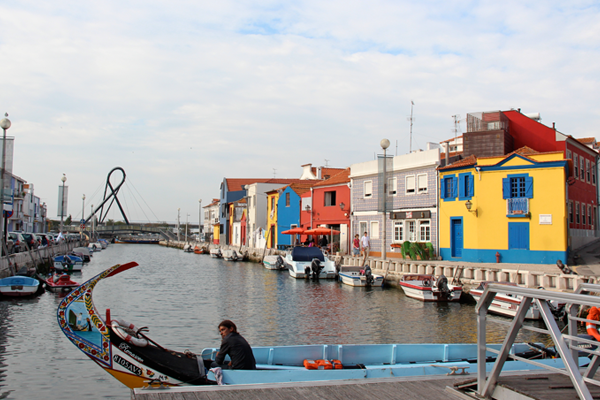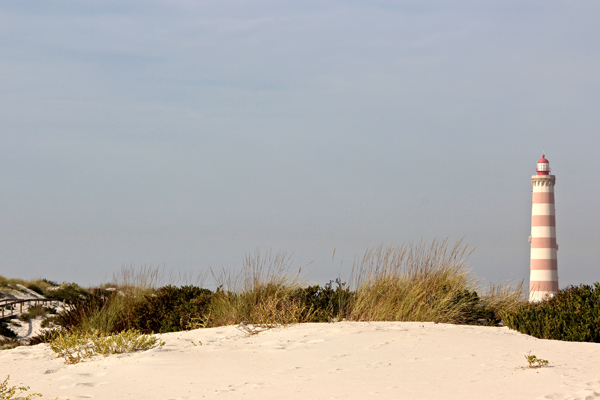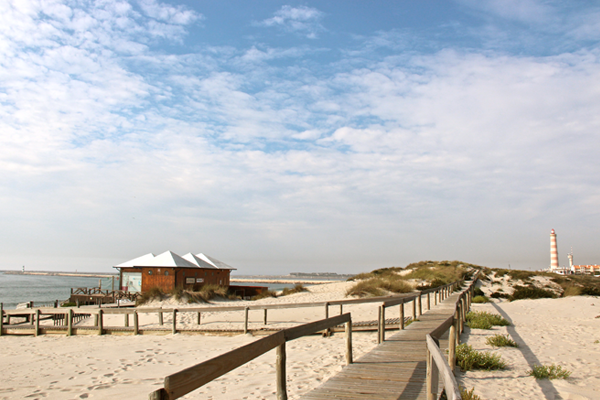Aveiro
Aveiro is a city located on the Atlantic coast of Portugal, in the Central Region, at about 250 km to the North of Lisbon and 70 km to the South of Oporto. It is surrounded by beaches and by an extensive coastal lagoon called Ria de Aveiro. The city is crossed by canals, which give an unusual beauty and make the city known as the “Venice of Portugal”.

In the canals you can find the moliceiro, a traditional boat painted with bright colours and typical decorations.
In the old quarter of the city, tourists can see the quaint whitewashed houses of the fishermen and visit, early in the morning, the Mercado do Peixe (Fish Market), where occurs an auction of the fish caught during the night.

“Ria de Aveiro” and its canals, salt-pans and extensive beaches are some of the places of interest to visit in Aveiro. Tourists can discover Aveiro by traveling aboard the moliceiro along Ria de Aveiro, by BUGA (Aveiro free bikes) or simply on foot through the paths of Art Nouveau or of Contemporary Architecture of Aveiro University. The city is great for walking because it has no hills and its places of interest are easily accessible.


Aveiro is a prosperous city of commerce and services, as well as a centre of culture and leisure, inserted in a region wich that has a huge variety of natural, historical and cultural rural resources. In the surrounding area of Aveiro, tourists can visit beautiful beaches and dunes: S. Jacinto, Praia da Barra and Costa Nova beaches, with its enchanting striped colourful houses.

Aveiro is also a city renowned for the richness of its gastronomy with the delicious eel stew, a variety of fish soups and cod fish recipes and the well-known ovos moles (sweet eggs), sweetened egg yolk in candied casings shaped like fish or barrels. Portugal’s famous dried cod (bacalhau) is closely related to the history and daily lives of this region as you can easily find out visiting the nearby Portuguese Codsfish Capital: Ílhavo. At the square Praça do Peixe there are several restaurants with traditional food.
Attractions in Aveiro
Aveiro Museum
Established in 1911, the Aveiro Museum is located within the grandiose Convento de Jesus. This museum is regarded as one of the most significant sacred arts museums in the country. It exhibits a collection of Portuguese 17th and 18th Century paintings, meticulous tile work, elegantly carved features in gold, as well as, a rich display of vestments, jewellery and valuable relics. Aveiro Museum still possess deep a documentary one of centuries XV to the XIX.
Art Nouveau Museum
In Aveiro there are several interesting examples of buildings that represent the exuberantly ornamental taste typical of Art Nouveau. The Art Nouveau Museum has opened its doors in Aveiro, located in Casa Major Pessoa, a true icon of art nouveau. It is also a travel across time and knowledge. The Museum has an enchanting tea house where you can have a refreshing break.
Maritime Museum of Ílhavo
www.museumaritimo.cm-ilhavo.pt
The Maritime Museum of Ílhavo not only shows tangible evidence of the region’s extremely strong historical and cultural identity, but also pays tribute to “they that go down to the sea in ships and do business in great waters” (to quote the Bible). No wonder that this is one of Portugal’s most popular museums. The museum has a vast collection of items relating to the line-fishing of cod and the agro-maritime industry of the Aveiro Lagoon, including full-size boats. Besides the building that was distinguished with the prestigious Mies van der Rohe Award for Contemporary Architecture. The museum includes the Cod Aquarium that is the only one of its kind in the world. And is complemented by the Museum Ship Santo André, a ship that was once part of the Portuguese cod fishing fleet.
Vista Alegre
An attraction outside the city is the Vista Alegre Porcelain Factory, the first industrial unit dedicated to producing porcelain in Portugal founded in 1824. Nowadays, it is well-known around the world, with famous names such as Britain’s Elizabeth II and Spain’s Juan Carlos having commissioned pieces. Vista Alegre is more than a mere industrial unit, the factory, the 19th century social quarter, the Nossa Senhora da Penha de França , the Theatre, the Museum and the shops form the world of Portuguese porcelain. The Museum records the history of this famous porcelain and also organises guided tours of the industrial area and of some of Vista Alegre’s heritage buildings.
Beaches
Aveiro lies very close to the coast where you will find remarkably clean beaches and dunes (Praia da Barra, Costa Nova and São Jacinto), which are excellent for soothing days in the sun, long walks, tempting sea sports (good surfing beaches) or simply contemplating the ocean. Costa Nova is known for its charming wooden houses with colourful strips that are exceptionally uniques. The Lighthouse of Praia da Barra, built in the 19th century, stands out out as the highest lighthouse in Portugal, with 62 m high, its red and white stripes define the skyline of the praia da barra. The S. Jacinto Dunes’ Natural Reserve is a true paradise for fauna and flora observation. There are regular walking trails running throughout the year which allow for birdwatching of countless species which chose this place as their natural habitat.
Salinas (salt pans)
Salt pans are rectangular ponds alongside the river linked together by small canals, whose workings are controlled by the ancestral knowledge of the marnoto (salt panner). The art of making salt is bound up with the history of the city and, today you can try your hand at the craft at the Troncalhada Ecomuseum, one of the salt pans that still operates in the area. In the salt pans you can understand why they call it the mirrors of heaven and see the salt pyramids that shine in the sun.








